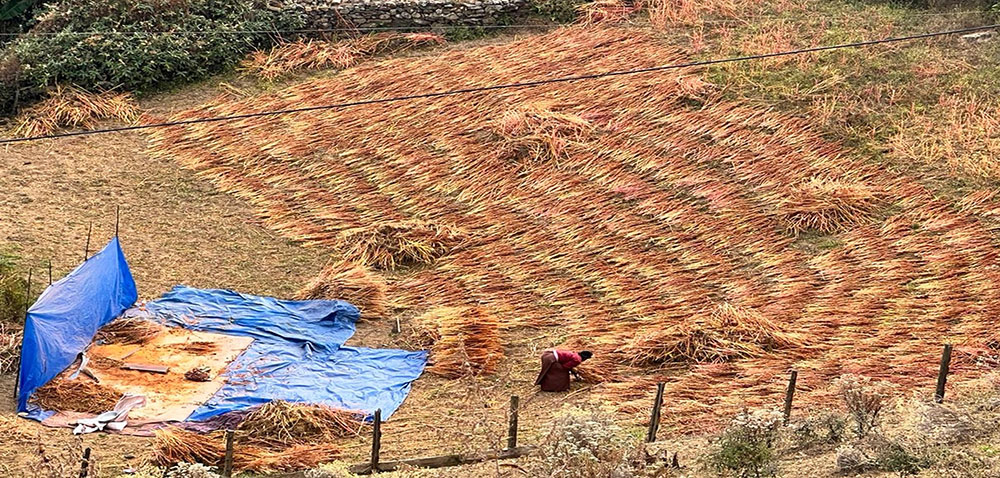YK Poudel
Germination problems, timeliness of sowing, care after germination, mechanisation knowledge, damage caused by rainfall, frost and birds are among the top issues facing quinoa farming in Bhutan.
These issues were discussed during the two-day Quinoa Production and Breeding workshop held at the National Centre for Organic Agriculture (NCOA), which was attended by 20 quinoa specialists from various agriculture research centres across the country and relevant agencies.
The Department of Agriculture (DoA), with technical and funding assistance from the UN Food and Agriculture Organization (FAO) Bhutan, has set an ambitious goal to produce 250 metric tonnes (MT) of quinoa on 1,000 acres of land in 14 dzongkhags in the 13th Plan.
Quinoa, known as Ashi Mo in the east and Rani Bethu in the south, is a nutritious cereal with high export potential, adaptable to different agro-ecological zones. Quinoa can be rotated with crops like potatoes, maize, paddy, wheat, and vegetables.

Last year, the country produced 13 MT of quinoa on 28 acres of farmland cultivated by 223 farmers.
Bhutan had 1,377 quinoa growers in 2020, but market challenges such as low value and price discouraged farmers from continuing quinoa cultivation.
As part of the Flexible Voluntary Contribution (FVC) project, titled “Productivity enhancement of priority crops through piloting and upscaling of tailored, innovative, climate-resilient, and sustainable agricultural practices in South Asian countries”, Bhutan, Bangladesh, and Nepal initiated a project in March this year worth USD one million. The project is set to conclude in December next year.
Bhutan is allocated USD 200,000 from the total FVC project amount, of which Nu six million has been allocated for training and capacity development.
The country is piloting 10 percent quinoa addition in the patient’s diet in various hospitals in partnership with the health ministry. There are plans to implement it in central schools and regional hospitals in the 13th Plan.
Specialist Tirtha Bahadur Katwal at the National Centre for Organic Agriculture (NCOA) in Yusipang said that the government has prioritised quinoa as a high-value crop, with all research centers and relevant agencies working collaboratively.
Favorable policies have been implemented, such as prioritising quinoa for school feeding programmes and hospitals, involving the Farm Machinery Corporation Limited as an aggregator, maintaining a price guarantee system by the finance ministry, and designating quinoa as the “One Country, One Product” commodity, making it a leading priority crop in the 13th Plan.
“The department’s plan focuses on initiating high-yielding and tri-color varieties that are adaptable,” said Tirtha Bahadur Katwal. “Through the Brand Bhutan initiative, including Geographical Indication and Geographical Indication Environmental Sustainability, we aim to promote the unique value of quinoa, considering environmental aspects.”
He explained that strategies such as the free supply of seeds, buy-back at favorable prices, and support for processing machines are among the initiatives taken so far. “While challenges at production, post-production, and marketing stages exist, opportunities in post-production and marketing are promising.”
Quinoa is well-suited to the southern lowlands and interior highlands. “The issue in higher elevations is the short growing season, but sowing at the right time can help achieve better yields,” he said.
Namgay Wangdi, a quinoa expert who previously worked with the Agriculture Research and Development Centre in Wengkhar, said that nine varieties have been tested in the country since its introduction in 2015, four of which are thriving. “Quinoa grows well in six southern dzongkhags, especially in the east, where the temperature ranges between 10°C and 38°C.”
So far, agriculture extension officials and about 500 farmers from 19 gewogs in the east have been trained in quinoa farming. Bartsham in Trashigang produces the highest amount of quinoa.
“While most farmers in the east have their own stored seeds, the ARDC has distributed 2,172.5 kg of seeds so far, with 4,827 kg remaining for interested farmers,” Wangdi said. “The government should provide electric dehusking machines for the convenience of farmers.”
He also noted that the government’s electric and chain-link fencing and irrigation plans are beneficial for crop protection and growth enhancement.
The government has allocated Nu 10.23 billion for the renewable natural resources sector for the financial year 2024-25, including Nu 910.5 million in the 13th Plan for agriculture marketing and cooperatives. Also, 100 percent foreign direct investment in the agriculture sector has been declared starting in June this year, along with other investment plans.
Quinoa can be used to prepare about nine different types of food, with quinoa porridge and pancakes being the most popular.
The workshop, which concludes today, is being facilitated by experts from NCOA, ARDC, and FAO’s regional expert, Dr Hui Zhang.


